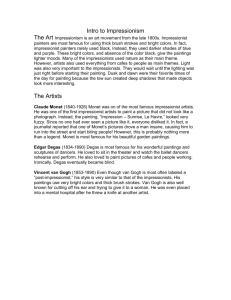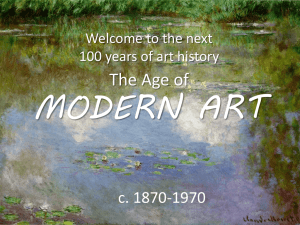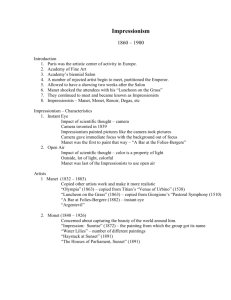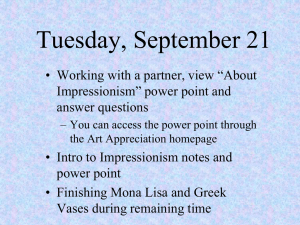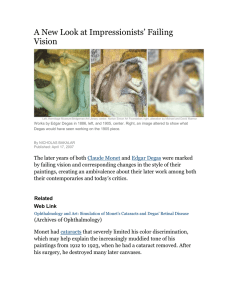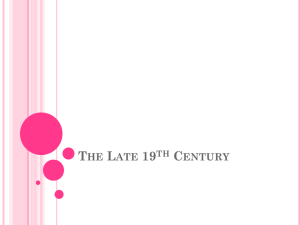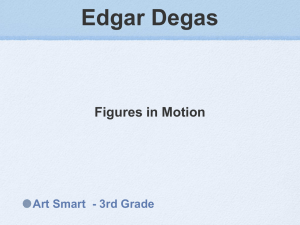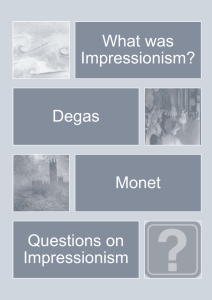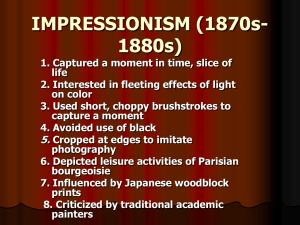Impressionism - McCray Art
advertisement
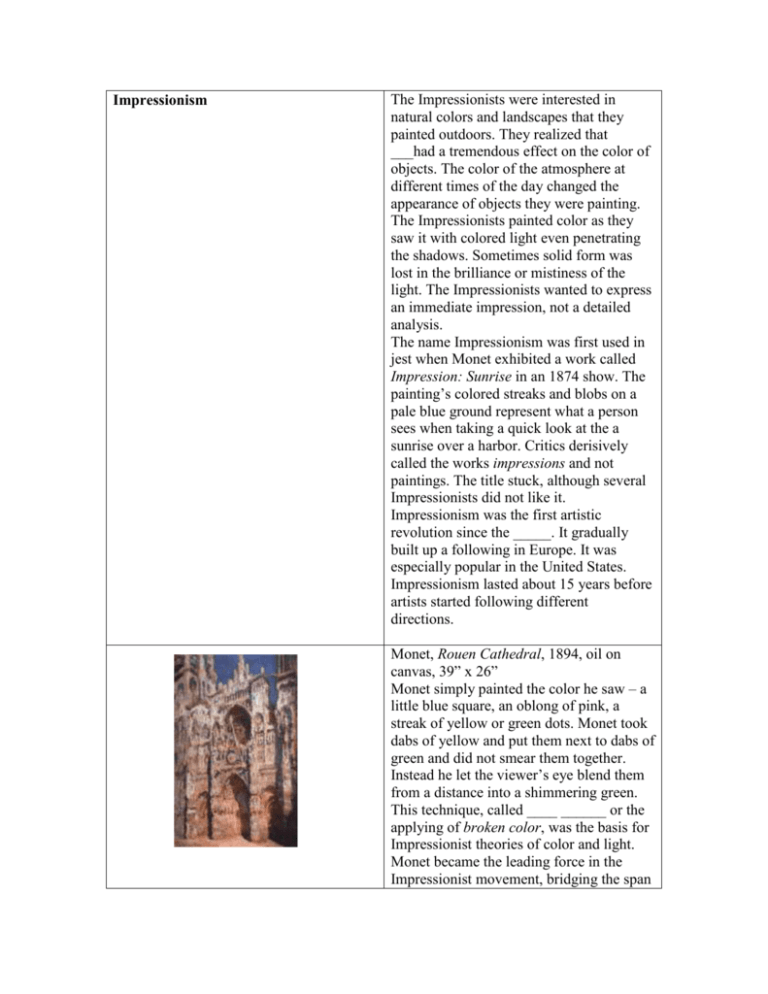
Impressionism The Impressionists were interested in natural colors and landscapes that they painted outdoors. They realized that ___had a tremendous effect on the color of objects. The color of the atmosphere at different times of the day changed the appearance of objects they were painting. The Impressionists painted color as they saw it with colored light even penetrating the shadows. Sometimes solid form was lost in the brilliance or mistiness of the light. The Impressionists wanted to express an immediate impression, not a detailed analysis. The name Impressionism was first used in jest when Monet exhibited a work called Impression: Sunrise in an 1874 show. The painting’s colored streaks and blobs on a pale blue ground represent what a person sees when taking a quick look at the a sunrise over a harbor. Critics derisively called the works impressions and not paintings. The title stuck, although several Impressionists did not like it. Impressionism was the first artistic revolution since the _____. It gradually built up a following in Europe. It was especially popular in the United States. Impressionism lasted about 15 years before artists started following different directions. Monet, Rouen Cathedral, 1894, oil on canvas, 39” x 26” Monet simply painted the color he saw – a little blue square, an oblong of pink, a streak of yellow or green dots. Monet took dabs of yellow and put them next to dabs of green and did not smear them together. Instead he let the viewer’s eye blend them from a distance into a shimmering green. This technique, called ____ ______ or the applying of broken color, was the basis for Impressionist theories of color and light. Monet became the leading force in the Impressionist movement, bridging the span from the Realist world to the contemporary world of abstraction. Monet loved to work outdoors and confront the environment he was painting. To analyze the change of color of a subject during various times of the day, he painted the west façade of Rouen Cathedral. One no longer sees the heavy stone, but rather the light and color reflected. Monet recorded the light and color changes on the church in more than thirty canvases. Manet, Gare Saint-Lazare, 1873, oil on canvas, 36” by 45” Manet wanted to make paintings that could be enjoyed for their color and arrangement, as well as for the fact they were paintings and not imitations of nature. His early works had ______ new to the world of painting. This flatness was hard for his contemporaries to understand and accept. Manet was influenced by _____ woodcuts that were popular imports in France. His Gare Saint-Lazare, done in mid-career, has a flatness that is fascinating. The woman’s face has little to no shadow, a stark contrast with the figures of the Renaissance. The light source is probably behind the artist. The format of the painting is like a snapshot of a young woman and a girl at the train station. The dominant vertical bars are fresh and startling. Manet, like Monet, often worked outside. All four sides of the canvas seem to have been _____ much as one would crop a snapshot. Manet’s work occasionally seems unfinished and casual, a stark contrast with Ingres and David. Degas, Blue Dancers, 1899, pastel on paper, 25” by 25” Edgar Degas shared the Impressionists interest in casual subjects and candid glimpses of people in action, but Degas more carefully considered design and the positioning of people and objects on the canvas. Degas was a master of line and drawing and was reluctant to abandon this in favor of Impressionism’s soft contours. One series Degas spent much of his time on was the ____. The views are from peculiar vantage points, such as from wings, balcony boxes or from below the stage. This enhances Degas’ candid glimpses of dancers working at their craft. Degas’ soft blending of costume into background is an Impressionist technique for showing light bouncing off of form. However, as a line around a foot or down a leg suggests, Degas only uses softness to express action or to describe the material. An ______ balance is often carefully used in the composition. Degas worked a great deal with _____ rather than with oils. He was the first artist to exhibit them as finished works instead of preliminary sketches for paintings. Cassat, Sleeping Baby, 1910, pastel on paper, 25” by 20” Cassatt studied with Degas. Mothers and children were Cassat’s favorite subjects. She worked in oil and pastel. Like Degas, Cassatt used ____ along legs and arms to strengthen the design and add solidity to the figures. Whistler, Arrangement in Gray and Black No. 1: The Artist’s Mother, 1871, oil on canvas, 56” by 63” Whistler, Nocturne in Black and Gold: The Falling Rock, 1874, oil on panel, 23” by 18” James Abbott McNeil Whistler was especially influenced by Japanese woodblock prints and the stark arrangements of Degas. He looked to simplification, realistic portraits, thin glazes of color and restricted palette, often of blacks and grays. Nocturne in Black and Gold: The Falling Rocket created much controversy. The painting is an impressionistic view of rockets bursting in the English night. Rodin, The Three Shades, 1881-86, Bronze Rodin transformed the instantaneity of Impressionism into powerful __________. Rodin’s best works were caste in bronze, but were first formed with his hands in clay, plaster or wax. He loved the immediacy of these materials, which he could manipulate, push, stab and form. Impressionist paintings may seem unfinished but are complete. In the same way Rodin often left his sculptures seemingly ______. Often the surfaces of his bronzes shimmer with light reflecting from his fingerprints and rough surfaces. Rodin’s work was not accepted during his lifetime, but has since his death been important to the history and progression of sculpture and modernist art.
